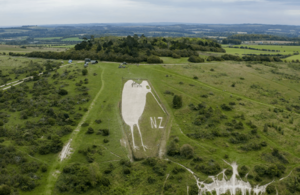Giant Kiwi monument shines after chopper chalk drop
The well-loved 'Bulford Kiwi' monument has been restored after an RAF helicopter flew in 10 tonnes of chalk.

Image of Bulford Kiwi depicted from chalk at Beacon Hill
- Well-loved ‘Bulford Kiwi’ monument restored by the Defence Infrastructure Organisation (DIO)
- The monument was created by New Zealand soldiers waiting to return home after the First World War
- RAF helicopter flew in 10 tonnes of chalk before volunteers set to work
A historically significant monument, created by New Zealand soldiers during World War I, has been restored in Wiltshire after a collective effort from UK Defence, the New Zealand High Commission and volunteers.
The ‘Bulford Kiwi’ is a large depiction of a kiwi, carved in the chalk on Beacon Hill above the village of Bulford on Salisbury Plain in Wiltshire. It was carved by soldiers from the New Zealand Expeditionary Force who were waiting to return home following the end of World War I.
After the war had been won, the New Zealand soldiers still in the UK decided to leave their mark on the countryside before they returned home. They carved a kiwi, a New Zealand icon, into the chalk of Beacon Hill.
DIO partnered with the New Zealand High Commission, local conservation groups, Landmarc and volunteers from the 3rd (UK) Division Signal Regiment and Operation Nightingale to restore the impressive carving.
As part of the project to ensure the historic significance of the kiwi is preserved, an RAF Chinook helicopter flew over the site and dropped 10 tonnes of chalk, which was then raked into place by volunteers across the partnership groups. A Waiata song and Kukuri dance were performed.
As the All Blacks prepare to take on Italy at the Rugby World Cup on Friday, DIO has highlighted the connection between the soldiers who created the Kiwi and the ‘Trench All Blacks’ – a team of soldiers from New Zealand who won ‘The Somme Cup’, a special rugby division for those fighting in the war.
The soldiers who created the monument fought alongside the ‘Trench All Blacks’ during the Battle of Messines – often regarded as one of the most successful battles of the war.
Richard Osgood, DIO’s senior archaeologist and co-founder of Operation Nightingale, said:
DIO is responsible for looking after 772 scheduled monuments across the MOD estate – dating from the pre-historic era right up to the Cold War.
Although the Bulford Kiwi is one of the youngest, being constructed in 1919, it is of national and international importance, given its association with the Armed Forces of New Zealand. This annual re-chalking reinforces the bonds between our countries and reminds us of the sacrifices made in the First World War.
Flight Lieutenant James Patrick piloted the Chinook helicopter, a special task for him as a pilot on an exchange programme from New Zealand.
Flight Lieutenant, James Patrick said:
It’s only since I came over to the UK on the exchange programme that I found out more about the Bulford Kiwi – I did know there was a chalked kiwi in the UK, but that was about it. I’ve flown over it a few times, which is interesting because it looks totally different from the air than it does from land.
The fact that it was made by New Zealand soldiers waiting to go home after the First World War just makes it special. Then knowing I’m involved in restoring it, it’s just awesome to be honest.
The soldiers who made this were fighting with the British forces on the Western Front, and I think that is important for us to remember. We have these relationships and things like this are perfect for us to keep up those bonds.
Shannon Austin, the New Zealand Deputy High Commissioner, said:
What a fantastic day it has been meeting and working with so many dedicated and enthusiastic volunteers. The Bulford Kiwi is well loved and has a long history that links the UK and New Zealand.
It has been a real pleasure to be involved in helping to protect and restore this significant monument.
Background
- The Bulford Kiwi, which stretches 130 metres (420 feet), was declared a scheduled monument in 2017, meaning it is recognised as a nationally important archaeological site and is now protected from destruction or change.
- Over the years, the Kiwi has been looked after by the New Zealand High Commission and local conservation groups.